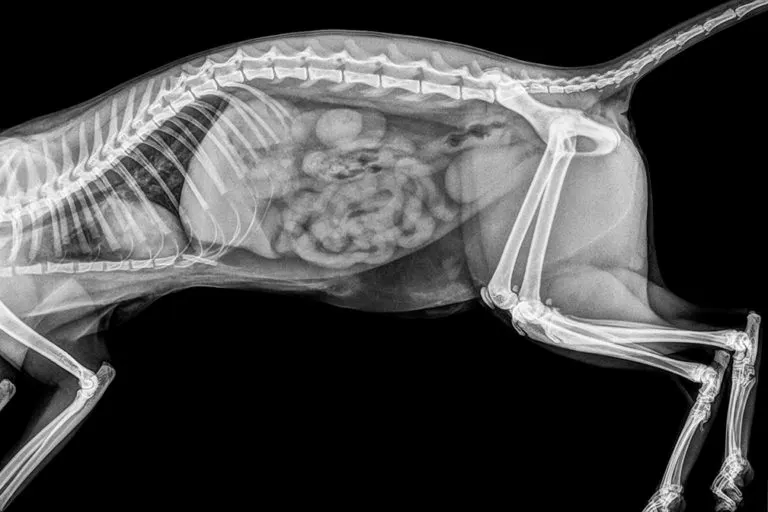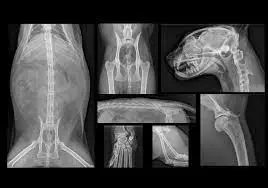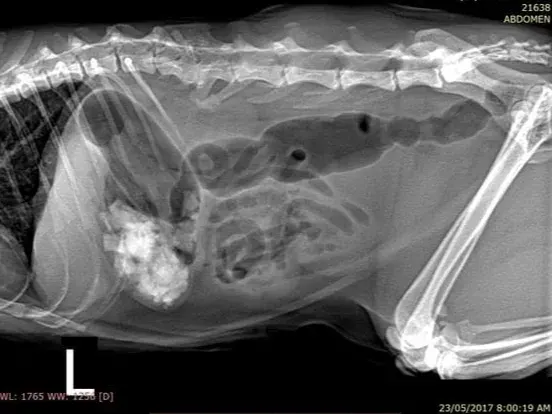How to interpret cat X-rays: 3 Essential Methods
Introduction
Mastering the basics of cat X-ray analysis is crucial in veterinary medicine. It offers vital information for accurate diagnosis, effective treatment planning, and overall feline health management. This guide introduces veterinarians and vet students to the fundamentals of interpreting cat radiographs. Focusing on both skeletal and soft tissue imaging, we explore the specifics of feline radiography interpretation. Ideal for both experienced practitioners and newcomers, our guide simplifies complex concepts, ensuring a thorough understanding of this essential diagnostic tool.

Exploring Cat X-rays: Detailed Guide on Skeletal and Soft Tissue Imaging
Cat X-rays are critical radiographic tools in veterinary practices. These imaging techniques provide detailed visuals of bones, organs, and other internal structures, offering a comprehensive look into the health of a cat. Here, we explain the significance of cat X-rays and their role in veterinary diagnostics. By understanding the different imaging techniques—skeletal and soft tissue—you can make informed decisions in various clinical scenarios, from fracture detection to identifying organ abnormalities.
Skeletal vs. Soft Tissue Imaging: Understanding Different Types
Cat X-rays are divided into two main types: skeletal and soft tissue imaging. Each serves a unique purpose in assessing feline health.
Skeletal Imaging: These images focus on bones, joints, and skeletal structure, crucial for diagnosing fractures, joint disorders, and bone diseases. Common applications include assessing injury severity and monitoring bone development.

Soft Tissue Imaging: This type provides a broader view of the internal organs and soft tissues, essential for examining conditions affecting organs like the lungs, liver, and heart. Useful for diagnosing organ disorders, monitoring disease progression, and guiding surgical planning.

How to Prepare Your Cat for anX-ray
Preparing your cat for an X-ray is an important step to ensure the safety and effectiveness of the procedure. Proper preparation can help minimize stress for both the cat and the veterinary staff. Here’s how you can prepare your cat for an X-ray:
- Fasting: Depending on the area being examined, you may need to withhold food from your cat for several hours before the X-ray. Always follow the specific instructions provided by your veterinarian.
- Sedation: To keep your cat still during the X-ray, sedation might be necessary, especially if the cat is anxious or in pain. Discuss with your veterinarian whether sedation is appropriate for your cat.
- Comfort: Bring a familiar blanket or toy to the vet to help comfort your cat during the visit.
- Transportation: Use a secure, comfortable carrier to transport your cat to the vet. This can help reduce stress on the way to and from the appointment.
- Medical History: Provide your veterinarian with a complete medical history of your cat, including any previous illnesses and treatments, which can be crucial for accurate diagnosis and safe X-ray procedure.
Indications for Cat X-rays: When and Why They Are Needed
Cat X-rays are indispensable tools for various veterinary conditions and scenarios. Key reasons for performing a cat X-ray include:
- Symptom Investigation: For symptoms like lethargy, unexplained pain, or difficulty breathing, X-rays provide a clear view of internal issues.
- Routine Veterinary Check-ups: Especially important for cats with a history of medical issues.
- Pre-Surgical Assessment: Crucial before many surgical procedures to thoroughly evaluate the feline's health.
- Disease Monitoring: Invaluable for tracking the progress of diagnosed conditions.
Understanding when and why cat X-rays are necessary is essential for veterinarians and cat owners in managing feline health effectively.
Expert Techniques for Interpreting Cat X-rays
The interpretation of cat X-rays involves a detailed process, depending on the expertise and tools available. We outline three effective methods:
1. AI-Assisted Analysis with X-ray Interpreter
X-ray Interpreter utilizes advanced AI technology for accurate, swift interpretations of cat X-ray images. It's user-friendly and ideal for rapid, dependable analysis.
Follow these steps for an AI-generated analysis of your X-ray images:
- Registration: Sign up on X-ray Interpreter to access the AI-based analysis.
- Uploading X-rays: Upload your cat X-ray images onto the platform.
- Reviewing Interpretation: Review the AI-generated interpretation and download the report.
- Seeking Professional Advice: Consult with veterinary professionals to understand the interpretation in a clinical context.
Please check out our get started guide.
2. Interactive Analysis with ChatGPT Plus
ChatGPT Plus leverages the powerful GPT-4V model to provide insightful analysis of cat X-ray images. This method offers a more interactive experience, allowing you to engage with the AI and tailor the analysis to your needs:
- Subscription: Subscribe to ChatGPT Plus to access GPT-4V for image analysis.
- Uploading X-rays: Navigate to the GPT-4V interface on the OpenAI platform and upload your cat X-ray images.
- Requesting Analysis: Request an analysis of the X-ray images by inputting natural language commands or questions.
- Reviewing and Confirming Analysis: Review the provided analysis, iterate for more detailed or specific information if necessary.
- Consulting Professionals: Seek advice from veterinary professionals to validate the analysis provided by GPT-4V.
Please read our post on how to use ChatGPT Plus for cat X-ray analysis to learn more.
Alternatively, as several other AI models with vision capabilities emerge, you can also try other models, such as Grok by xAI, Claude by Anthropic, Gemini by Google Deepmind.
3. Self-Reading Cat X-rays
Self-reading is a traditional method that relies on individual expertise and resources. It's ideal for veterinarians aiming to improve their interpretative skills. This method requires a solid understanding of veterinary radiology and a commitment to continuous learning:
- Education: Gain foundational knowledge and training on reading and interpreting cat X-rays through coursework or from reputable sources.
- Practice: Practice interpreting cat X-rays under the guidance of experienced professionals.
- Resources: Utilize books, online resources, and veterinary literature to expand your understanding and skills in interpreting cat X-rays.
- Seeking Feedback: Obtain feedback from knowledgeable professionals to refine your interpretation skills.
- Continuous Learning: Continuously update your knowledge and skills by engaging in professional discussions, attending workshops, and reading recent veterinary literature.
Recommended Resources for Self-Reading:
-
Feline Radiographs: An Introduction | Long Beach Animal Hospital:
- This resource provides a thorough introduction to interpreting feline radiographs, covering both common and uncommon findings, and explains how to distinguish between healthy and pathological signs on X-rays. Explore the resource here.
-
Veterinary Imaging Anatomy | College of Veterinary Medicine at Illinois:
- A comprehensive educational resource that provides extensive imaging anatomy resources useful for interpreting feline radiographs, featuring detailed anatomical diagrams and descriptions. Learn more about imaging anatomy.
-
Interpreting Feline Radiographs | Long Beach Animal Hospital:
- A detailed guide to reading and understanding various feline radiographs, this resource discusses techniques for identifying normal and pathological features in X-rays. Read more here.
Comparative Review of Cat X-ray Interpretation Methods
Choosing the right method for interpreting cat X-rays is key to accurate diagnosis and effective feline care. In this comparative analysis, we evaluate the three methods - AI-assisted interpretation with X-ray Interpreter, interactive analysis with ChatGPT Plus, and traditional self-reading. Our comparison is based on accuracy, ease of use, cost, time efficiency, and the availability of additional resources. This evaluation aims to provide a clear understanding of each method's strengths and limitations, helping you make an informed decision tailored to your specific needs and expertise in cat X-ray interpretation.
| Criteria | X-ray Interpreter | ChatGPT Plus | Self-Reading |
|---|---|---|---|
| Accuracy | Mostly High (AI-based)1 | Mostly High (AI-based)1 | Varies (Skill-dependent) |
| Ease of Use | Easy | Moderate | Challenging |
| Cost | Starting from $2.50 per image | $20 per month | Free (excluding educational costs) |
| Time Efficiency | Fast | Moderate to Fast | Slow to Moderate |
| Learning Curve | Low | Low to Moderate | High |
| Additional Resources | Provided | Partially Provided (through OpenAI) | Self-sourced |
Summing Up: The Importance of Accurate Cat X-ray Analysis
Interpreting cat X-rays is a critical skill in veterinary practice, aiding in the diagnosis and management of various feline health conditions. This guide has provided an overview of three different methods to interpret cat X-rays: utilizing X-ray Interpreter, using ChatGPT Plus, and self-reading. Each method caters to different levels of expertise and circumstances, offering a range of options for individuals and professionals alike.
In a rapidly evolving veterinary landscape, staying updated with the latest technologies and methodologies is crucial for providing accurate and timely patient care. Regardless of the method chosen, adhering to legal guidelines and ethical practices is paramount to ensure the privacy, safety, and well-being of feline patients.
This guide serves as a starting point in exploring the various methods of cat X-ray interpretation, with the hope of aiding individuals and professionals in navigating this crucial aspect of veterinary diagnostics. The choice between these methods ultimately depends on personal preferences, professional goals, and the specific circumstances at hand.
Related Articles
Resources and Further Learning
For those interested in delving deeper into the realm of feline X-ray interpretation, here are some additional resources that offer further insights and structured approaches:
-
Feline Diagnostic Imaging | Belton Veterinary Clinic:
- This resource covers ultrasound, MRI, X-rays, and radiology, offering a deep dive into the diagnostic imaging options available for feline health. Visit Belton Veterinary Clinic for more information.
-
Radiographs (X-Rays) for Cats | VCA Animal Hospitals:
- VCA Hospitals provide a comprehensive guide to understanding how radiographs are used in diagnosing and monitoring various conditions in cats. Learn about feline radiographs at VCA Hospitals.
-
Radiographs (X-Rays) for Cats: Costs & How It Works | Cats.com:
- This article from Cats.com discusses the costs associated with feline radiographs and explains the procedure in detail, making it a valuable resource for cat owners. Read more at Cats.com.